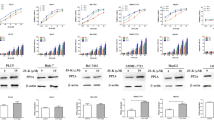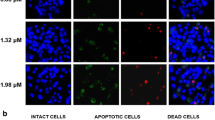Abstract
The objective of this study was to establish whether apoptosis in 5123tc rat hepatoma cells required the caspase-3 dependent pathway. Apoptosis was induced by either growth factor deprivation or treatment with a topoisomerase II inhibitor, VM26, in the absence or presence of caspase inhibitors (DEVD-fmk, z-VAD-fmk and BAF). The results indicated that, although these inhibitors at 10 μM concentration completely blocked caspase-3 activity, they had no effect on either the rate of cell death or on any other apoptotic features, e.g., chromatin condensation, DNA fragmentation, protein cleavage, suggesting that caspase-3 was not required to mediate nuclear destruction in these hepatoma cells. At higher concentrations, up to 100 μM, z-VAD-fmk and BAF, but not DEVD-fmk, did block apoptosis, however, they also caused cell swelling and membrane permeabilization, which are the hallmarks of necrotic cell death. Clearly, high concentrations of these inhibitors must have interfered non-specifically with other metabolic pathways, e.g., z-VAD-fmk at a high concentration blocked protein phosphorylation, and caused cell death by a different mechanism.
Similar content being viewed by others
References
Kerr JF, Wyllie AH, Currie AR. Apoptosis: A basic phenomenon with wide ranging implications in tissue kinetics. Br J Cancer 1972; 26: 239–257.
Wyllie AH. Cell Death: A new classification separating apoptosis from necrosis. In: Bowen ID, Lockshin RA, eds. Cell Death in Biology and Pathology. London: Chapman and Hall 1991: 9–34.
Nicholson DW, Thornberry NA. Caspases: Killer proteases. Trends Biochem Sci 1997; 22: 299–306.
Enari M, Sakahira H, Yokoyama H, Okawa K, Iwamatsu A, Nagata S. A caspase-activated DNase that degrades DNA during apoptosis and its inhibitor ICAD. Nature 1998; 391: 43–50.
Tang D, Kidd VJ. Cleavage of DFF-45/ICAD by multiple caspases is essential for its function during apoptosis. J Biol Chem 1998; 273: 28549–28552.
Janicke RU, Sprengart ML, Wati MR, Porter AG. Caspase-3 is required for DNA fragmentation and morphological changes associated with apoptosis. J Biol Chem 1998; 273: 9357–9360.
Liu X, Slaughter C, Wang X. DFF, a heterodimeric protein that functions downstream of caspase-3 to trigger DNA fragmentation during apoptosis. Cell 1997; 89: 175–184.
Kuida K, Lippke JA, Ku G, et. al. Altered cytokine export and apoptosis in mice deficient in interleukin-1 beta converting enzyme. Science 1995; 267: 2000–2003.
Li P, Allen H, Banerjee, et al. Mice deficient in IL-1 beta converting enzyme are defective in production of mature IL-1 beta and resistant to endotoxic shock. Cell 1995; 80: 401–411.
Wang S, Miuyra M, Bergeron L, Zhu H, Yuan J. Murine caspase-11, an ICE interacting protease is essential for the activation of ICE. Cell 1998; 92: 501–509.
Bergeron L, Perez GI, McDonald, et al. Defects in regulation of apoptosis in caspase-2 deficient mice. Genes Dev 1998; 12: 1304–1314.
Kuida K, Zhang TS, Na S, et al. Decreased apoptosis in the brain and premature lethality in CPP32-deficient mice. Nature 1996; 384: 368–372.
Oberhammer F, Wilson JW, Dive, et al. Apoptotic death in epithelial cells: Cleavage of DNA to 300 and/or 50 kb fragments prior to or in the absence of internucleosomal fragmentation. EMBO J 1993; 12: 3679–3684.
Walker PR, LeBlanc J, Carson C, Ribecco M, Sikorska M. Neither caspase-3 nor DNA fragmentation factor are required for high molecular weight DNA degradation in apoptosis. Annals of New York Acad Sci 1999; 887: 48–59.
Morris HP. Studies on the development, biochemistry, and biology of experimental hepatomas. Adv Cancer Res 1965; 9: 227–302.
Walker PR, Kokileva L, LeBlanc J, Sikorska M. Detection of the initial stages of DNA fragmentation in apoptosis. Biotechniques 1993; 15: 1032–1041.
Walker PR, LeBlanc J, Smith B, Pandey S, Sikorska M. Detection of DNA fragmentation and endonucleases in apoptosis. Methods1999; 17: 329–338.
Kawahara A, Ohsawa Y, Matsumura H, Uchiyama Y, Nagata S. Caspase-independent cell killing by Fas-associated protein with death domain. J Cell Biol 1998; 143: 1353–1360.
Jones BE, Lo CR, Liu H, et al. Hepatocytes sensitized to tumor necrosis factor cytotoxicity undergo apoptosis through caspasedependent and caspase-independent pathways. J Biol Sci 2000; 275: 705–712.
Samejima K, Tone S, Kottke TJ, et al. Transition from caspasedependent to caspase-independent mechanisms at the onset of apoptotic execution. J Cell Biol 1998; 143: 225–239.
Cohen GM. Caspases: The executioners of apoptosis. Biochem J 1997; 326: 1–16.
Milligan CM, Prevette D, Yaginuma H, et al. Peptide inhibitor of ICE protease family arrest programmed cell death of motoneurons in vivo and in vitro. Neuron 1995; 15: 385–393.
Lzebnik YA, Kaufmann SH, Desnoyers S, Poirier GG, Earnshaw WC. Cleavage of poly(ADP-ribose) polymerase by a proteinase with properties like ICE. Nature 1994. 371: 346–347.
Woo M, Hakem R, Soengas, et al.Essential contribution of caspase-3/CPP32 to apoptosis and its associated nuclear changes. Genes Dev 1998; 12: 806–819.
Medema JP, Scaffidi C, Krammer PH, Peter ME. Bcl-xL acts downstream of caspase-8 activation by CD95 death-inducing signaling complex. J Biol Chem 1998; 273: 3388–3398.
Pandey S, Walker PR, Sikorska M. Identification of a novel 97 kDa endonuclease capable of internucleosomal DNA cleavage. Biochemistry 1997; 36: 711–720.
Liu QY, Pandey S, Singh, et al. DNase Y: A rat DNase I-like gene coding for a constitutively expressed chromatin-bound endonuclease. Biochemistry 1998; 37: 10134–10143.
Liu Q, Ribecco M, Pandey S, Walker PR, Sikorska M. Apoptosis-related functional features of the Dnase-I like family of nucleases. Annals of New York Academy of Sciences 1999; 887: 60–76.
Swe M, Sit KH. z-VAD-fmk and DEVD-cho induced late mitosis arrest and apoptotic expressions. Apoptosis 2000; 5: 29–36.
Vercammen D, Brouckaerr G, Denecker G, Craen MVD, DeclercqW, FiersW. Dual signaling of the Fas receptor: Initiation of both apoptotic and necrotic cell death pathways. J Exp Med 1998; 188: 919–930.
Mills JC, Stone NL, Erhardt J, Pittman RN. Apoptotic membrane blebbing is regulated by myosin light chain phosphorylation. J Cell Biol 1998; 140: 627–636.
Author information
Authors and Affiliations
Rights and permissions
About this article
Cite this article
Pandey, S., Smith, B., Walker, P.R. et al. Caspase-dependent and independent cell death in rat hepatoma 5123tc cells. Apoptosis 5, 265–275 (2000). https://doi.org/10.1023/A:1009608630145
Issue Date:
DOI: https://doi.org/10.1023/A:1009608630145




